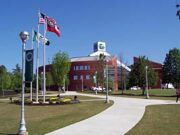A University System of Georgia (USG) institution, Georgia Gwinnett College in Lawrenceville serves Gwinnett County and the surrounding environs. The school was accredited in 2009 as a senior college by the Southern Association of Colleges and Schools (SACS).
Georgia Gwinnett, the first four-year public college created in the United States during the twenty-first century, is different by design from other similar institutions in that it attempts to combine the best practices in higher education with innovative approaches. For instance, Georgia Gwinnett’s faculty is not organized by department, nor do its members have tenure. The goal of this approach is to encourage cross-disciplinary exchanges, as faculty members perform various administrative functions through required service work.
Georgia Gwinnett maintains a focus on small class sizes that allow for substantive interactions between students and their instructors. In 2023 the school ranked twelfth among top public Southern regional colleges, according to U.S. News & World Report, and offered twenty-one majors and over sixty programs of study.
Origins of Georgia Gwinnett
The creation of Georgia Gwinnett was the culmination of efforts by Gwinnett County’s civic leadership over nearly three decades, combined with a series of bids from competing state educational institutions to establish themselves in Gwinnett County. The Gwinnett Chamber of Commerce founded an education committee in the early 1980s, under the direction of executive director Richard Tucker, to develop a publicly funded school of higher education for the county. In the mid-1980s, Gainesville Junior College (later Gainesville State College, now known as University of North Georgia) began offering classes in Gwinnett. In 1987 the Board of Regents replaced Gainesville State College with DeKalb Community College (later Georgia State University Perimeter College, now part of Georgia State University), in order to secure higher student enrollment for DeKalb Community College.
In the 1990s the University of Georgia and Georgia State University began offering graduate courses in Gwinnett County. These schools cooperated with Gwinnett Technical Institute (later Gwinnett Technical College) to form the Gwinnett Center, located on the Sugarloaf corridor adjacent to Gwinnett Tech. At this time Gwinnett County residents could pursue only a two-year degree or a graduate degree in their county.
In 1997 the Board of Regents authorized development of the Gwinnett University Center (now part of Georgia Gwinnett College) on a 160-acre site, which was provided by the Gwinnett County Commission, near the intersection of Collins Hill Road and University Parkway (Highway 316). Full approval and funding by the state legislature came the following year. The college was a public-private venture: a foundation created by the Gwinnett Chamber of Commerce retained possession of the land and buildings, while the USG provided the academic and administrative structure for the institution.
The Gwinnett University Center became operational in 2002 with two buildings; a third was added in 2005. Georgia Perimeter College provided the core curriculum classes, while the University of Georgia provided the upper-division classes for most majors. Additionally, Southern Polytechnic State University (later Kennesaw State University) and the Medical College of Georgia (later known as Georgia Health Sciences University, Georgia Regents University, and, finally, Augusta University) offered specialized course work. The University of Georgia graduated its first class from the Gwinnett campus in 2003, and by 2004, with a student enrollment exceeding 8,000, the Gwinnett campus exceeded enrollments at any of Georgia Perimeter College’s other campuses.
By 2004 the Board of Regents had initiated discussions about converting the Gwinnett University Center into a four-year institution. State Senator Don Balfour proved instrumental in moving the idea through the legislature in March 2005, and in June 2005 the Board of Regents transformed the facilities of Gwinnett University Center into a stand-alone four-year institution called Georgia Gwinnett College.
Institutional Growth
Georgia Gwinnett hired its first president, Dr. Daniel J. Kaufman, in September 2005. A retired brigadier general who served more than twenty years in the U.S. Army, including duty as the chief academic officer of the U.S. Military Academy at West Point, New York, Kaufman earned his doctorate in political science from the Massachusetts Institute of Technology. As Georgia Gwinnett’s first employee, Kaufman immediately set to work naming the college, designing the framework of how the institution would operate, and hiring all the initial staff. The faculty comprised ten members when the college opened in August 2006 and by the following year had grown to more than one hundred.
Because a college cannot become accredited without having first graduated a class of students, Georgia Gwinnett accepted 118 transfer students in 2006 in order to fast track its accreditation process. These students, like the college’s faculty and administrators, took a risk in coming to Georgia Gwinnett, given the uncertainty of its success. Their gamble paid off, however, and the ceremony for the inaugural graduation class of 17 students took place in June 2008, during the same week as the announcement of Georgia Gwinnett’s College’s candidacy for SACS accreditation. Accreditation was granted in 2009.
The student population grew dramatically in the years following the college’s opening. Starting with 118 students in 2006, the number climbed to nearly 3,000 students by fall 2009, and reached almost 8,000 in fall 2011. In the fall of 2022 the college has 11,030 enrolled students, about 65 percent of whom were enrolled full-time.
The college’s facilities expanded as well. Georgia Gwinnett opened with 177 acres and three buildings and soon thereafter added an admissions/student affairs facility, an athletic facility, and a parking deck. In fall 2010 a library, student center, and dormitory opened, and the following year, the college opened a laboratory facility and announced plans for creating an intercollegiate sports center along its Collins Hill corridor. By 2011, the college’s campus included at least 360,000 square feet of classrooms, laboratories, offices, computer labs, and assembly spaces, and additional property adjacent to campus had been purchased to accommodate future growth. In 2023 Georgia Gwinnett began construction on a 72,280 square-foot Convocation Center to accommodate new men’s and women’s basketball teams, among other recreational activities.




